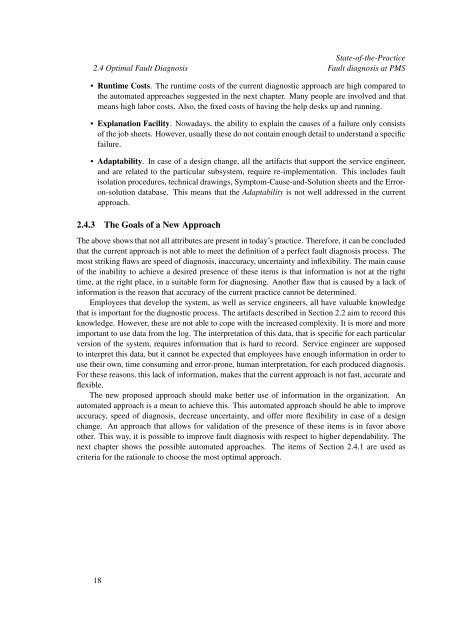pdf download - Software and Computer Technology - TU Delft
pdf download - Software and Computer Technology - TU Delft
pdf download - Software and Computer Technology - TU Delft
Create successful ePaper yourself
Turn your PDF publications into a flip-book with our unique Google optimized e-Paper software.
2.4 Optimal Fault Diagnosis<br />
State-of-the-Practice<br />
Fault diagnosis at PMS<br />
• Runtime Costs. The runtime costs of the current diagnostic approach are high compared to<br />
the automated approaches suggested in the next chapter. Many people are involved <strong>and</strong> that<br />
means high labor costs. Also, the fixed costs of having the help desks up <strong>and</strong> running.<br />
• Explanation Facility. Nowadays, the ability to explain the causes of a failure only consists<br />
of the job sheets. However, usually these do not contain enough detail to underst<strong>and</strong> a specific<br />
failure.<br />
• Adaptability. In case of a design change, all the artifacts that support the service engineer,<br />
<strong>and</strong> are related to the particular subsystem, require re-implementation. This includes fault<br />
isolation procedures, technical drawings, Symptom-Cause-<strong>and</strong>-Solution sheets <strong>and</strong> the Erroron-solution<br />
database. This means that the Adaptability is not well addressed in the current<br />
approach.<br />
2.4.3 The Goals of a New Approach<br />
The above shows that not all attributes are present in today’s practice. Therefore, it can be concluded<br />
that the current approach is not able to meet the definition of a perfect fault diagnosis process. The<br />
most striking flaws are speed of diagnosis, inaccuracy, uncertainty <strong>and</strong> inflexibility. The main cause<br />
of the inability to achieve a desired presence of these items is that information is not at the right<br />
time, at the right place, in a suitable form for diagnosing. Another flaw that is caused by a lack of<br />
information is the reason that accuracy of the current practice cannot be determined.<br />
Employees that develop the system, as well as service engineers, all have valuable knowledge<br />
that is important for the diagnostic process. The artifacts described in Section 2.2 aim to record this<br />
knowledge. However, these are not able to cope with the increased complexity. It is more <strong>and</strong> more<br />
important to use data from the log. The interpretation of this data, that is specific for each particular<br />
version of the system, requires information that is hard to record. Service engineer are supposed<br />
to interpret this data, but it cannot be expected that employees have enough information in order to<br />
use their own, time consuming <strong>and</strong> error-prone, human interpretation, for each produced diagnosis.<br />
For these reasons, this lack of information, makes that the current approach is not fast, accurate <strong>and</strong><br />
flexible.<br />
The new proposed approach should make better use of information in the organization. An<br />
automated approach is a mean to achieve this. This automated approach should be able to improve<br />
accuracy, speed of diagnosis, decrease uncertainty, <strong>and</strong> offer more flexibility in case of a design<br />
change. An approach that allows for validation of the presence of these items is in favor above<br />
other. This way, it is possible to improve fault diagnosis with respect to higher dependability. The<br />
next chapter shows the possible automated approaches. The items of Section 2.4.1 are used as<br />
criteria for the rationale to choose the most optimal approach.<br />
18
















